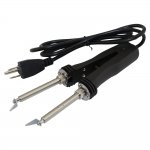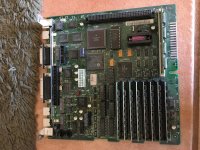-
Updated 2023-07-12: Hello, Guest! Welcome back, and be sure to check out this follow-up post about our outage a week or so ago.
You are using an out of date browser. It may not display this or other websites correctly.
You should upgrade or use an alternative browser.
You should upgrade or use an alternative browser.
Replacing se/30 capacitors question
- Thread starter Ultimategamer87
- Start date
joethezombie
Well-known member
Yes you can, but you'd be better off using tantalums. Also, replace that battery or remove it completely before it leaks.
Ultimategamer87
Member
Why would i be better off using tantalums? Just wondering.Yes you can, but you'd be better off using tantalums. Also, replace that battery or remove it completely before it leaks.
flashedbios2012
Well-known member
Are the surface mount caps the silver and black ones? How do you desolder those?
Ultimategamer87
Member
I have never done this before, but i have heard of people using hot air to desolder them.Are the surface mount caps the silver and black ones? How do you desolder those?
flashedbios2012
Well-known member
so a hair dryer? Or do I have to go purchase a hot air gun? I may just pay a local electronics repair shop to do it
Ultimategamer87
Member
You have to buy a special tool that blows really hot air (over 400 degrees f) to desolder them. Im actually just going to send my board to maccaps.com and have him recap it.so a hair dryer? Or do I have to go purchase a hot air gun? I may just pay a local electronics repair shop to do it
joethezombie
Well-known member
Yes, under those capacitors are very fine circuit traces on the motherboard and if you overheat them or scrape them you'll cause a lot of damage. You can also lift the pads if you don't do it right. Also keep in mind if the electrolytic fluid has escaped from the existing capacitors, that stuff is like acid and eats away at those traces so just replacing the capacitors may not be enough.
Edited to add, the reason why tantalums are better is because they will not leak in the future so one fixed now will last forever. If you use the electrolytics, just remember to do it again in 10 or so years or when the fluid leaks out again it will dissolve the traces.
Edited to add, the reason why tantalums are better is because they will not leak in the future so one fixed now will last forever. If you use the electrolytics, just remember to do it again in 10 or so years or when the fluid leaks out again it will dissolve the traces.
Last edited by a moderator:
flashedbios2012
Well-known member
they should have used tantalums to begin with
joethezombie
Well-known member
Yeah, they should have! Funny thing is, some boards like the Quadra 700 is all tantalum, and the IIfx board has pads for tantalums, but then they used those crappy aluminum cans! Video cards aer even stranger, some of them have tantalums and some of them have aluminum cans. It seemed that Apple just used what they could get the cheapest at the time of production.
Ultimategamer87
Member
Do you know about how much it will cost me to send my se/30 board to maccaps.com? I have 2 regular macintosh se computers that have never had to be recapped so im just wondering.Yes, under those capacitors are very fine circuit traces on the motherboard and if you overheat them or scrape them you'll cause a lot of damage. You can also lift the pads if you don't do it right. Also keep in mind if the electrolytic fluid has escaped from the existing capacitors, that stuff is like acid and eats away at those traces so just replacing the capacitors may not be enough.
Edited to add, the reason why tantalums are better is because they will not leak in the future so one fixed now will last forever. If you use the electrolytics, just remember to do it again in 10 or so years or when the fluid leaks out again it will dissolve the traces.
joethezombie
Well-known member
No idea. I've never used his services as I do all my own work. I would guess the SE/30 is one of the more complicated boards with a high capacitor count, so probably at the higher end of his scale. Go to his website and email him directly. There's also a few here that are starting to offer this service, maybe at a cost savings.
Ultimategamer87
Member
Could you possibly refer me to a person on this forum who does se/30 recaps?No idea. I've never used his services as I do all my own work. I would guess the SE/30 is one of the more complicated boards with a high capacitor count, so probably at the higher end of his scale. Go to his website and email him directly. There's also a few here that are starting to offer this service, maybe at a cost savings.
TimHD
Well-known member
See. https://68kmla.org/forums/index.php?/topic/28590-if-you-are-desperate-for-recap/Could you possibly refer me to a person on this forum who does se/30 recaps?
fimbulvetr
Well-known member
There are maccaps listings for recapping on eBay, which should give you an idea on what her charges.
Unknown_K
Well-known member
I tend to replace capacitors with the same type as used by the manufacturer if still available. Hobby machines don't get used the same as they were when new so even aluminum analytics should last a very long time.
Tantalum capacitors short closed (they explode), depending on the circuit that could be very bad. Also tants are not the best for audio circuits.
Tantalum capacitors short closed (they explode), depending on the circuit that could be very bad. Also tants are not the best for audio circuits.
SMD work is a little trickier than using a standard leaded radial cap. May also be worth getting a tool like this for smd work.
Less of a chance of pulling off one of the pads while removing the old caps ><
https://www.circuitspecialists.com/Tweezer-Style-Soldering-Iron-For-SMD.html

Less of a chance of pulling off one of the pads while removing the old caps ><
https://www.circuitspecialists.com/Tweezer-Style-Soldering-Iron-For-SMD.html

Honestly, it's just not that hard. The biggest requirement is patience followed by care with a dose of gentleness. Get two 40ish watt pencils at Radio Shack (I used to use the grounded 15W pencils but they're too weak), let them heat properly, apply liquid flux to the old solder, and then with one pencil in each hand apply a pencil to each side of the cap. Don't drill or grind. Just wait. If the joint doesn't seem to be heating, retip your pencil with solder and reapply flux to the joint. Heat conduction is key. Ideally the cap will be loose is about 5 seconds but sometimes it takes longer. Then you just lift it with the pencils and wipe it off on a damp sponge.
All the warnings about lifted pads and traces underneath are why you don't drill or grind the pencils into the board. Just gently apply heat until the cap comes loose.
All the warnings about lifted pads and traces underneath are why you don't drill or grind the pencils into the board. Just gently apply heat until the cap comes loose.
Similar threads
- Replies
- 15
- Views
- 484

